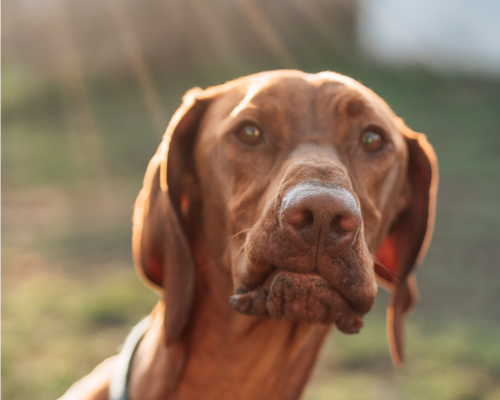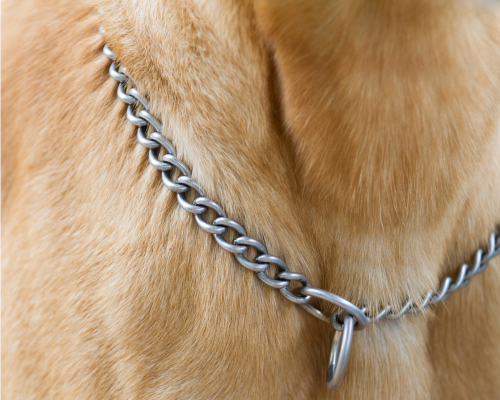Do Dogs Have Adam's Apples? Finally Answered!
Do Dogs Have Adam's Apples? Finally Answered!

Vet Reviewed

By: Sarah Hodgson
January 1, 2024
- Posted in Dogs
Table of Contents
You might have brushed your hand against your dog’s neck and noticed a bump. What is it? Do dogs have Adam’s apples or is it a lump? This question, surprisingly, is not as uncommon as you might think.
In this article, we will explore whether there are Adam’s apples in dogs, and, if so, what their role is.
Let’s dive in!
What Is an Adam’s Apple?
Before we dive into the question of whether dogs have Adam’s apples, let’s first understand what an Adam’s apple is.
The Adam’s apple, scientifically known as the laryngeal prominence, is
a visible bump-like area in the throat. It is larger and more visible in males due to the larger size of their larynx, which houses the vocal cords. It mainly grows larger during puberty when the vocal cords expand and grow larger. It’s essentially a natural part of the physical changes that occur during puberty, especially in males.
Just like us, dogs have a larynx, too, so does that mean that they have an Adam’s apple?

Do Dogs Have Adam’s Apples?
So now that we know what an Adam’s apple is, do dogs have one?
Yes, and No. All dogs, regardless of their gender, have a laryngeal prominence. Although dogs don’t have exactly what we call an Adam’s apple, they do have a bump.
There is no scientific term for this laryngeal prominence, so most people refer to it as an Adam’s apple, and we’ll just stick with that name for
the rest of this post.
Just like humans, dogs have a larynx and vocal cords, which contribute to the production of sound. This “Adam’s Apple” helps protect the vocal cords.
Although the Adam’s apple may not be as visible in dogs as it is in humans, it is still there. In some breeds, the Adam’s apple may be more visible due to the structure of their neck and throat. For example, dogs with longer necks or those with a thinner layer of muscle surrounding the larynx may have a more noticeable Adam’s apple. However, in most dogs, it may not be as apparent.
Do Female Dogs Have Adam’s Apples?
Yes, female dogs also have what we’re calling an Adam’s apple. While the size and visibility of the Adam’s apple may vary among individual dogs, it is a natural anatomical feature present in both male and female dogs. The prominence of the Adam’s apple is not related to the gender of the dog, but rather the size and structure of their larynx, which depends on their dog breed and genetics.
Do Dogs Have Big Adam’s Apples?
Now that we know dogs have Adam’s apples, how big are they?
- The size of a dog’s Adam’s apple can vary depending on the individual dog’s genetics and its breed.
- Some dogs may have larger and more noticeable Adam’s apples, while others may have smaller ones that are less prominent.
- The size of the Adam’s apple is influenced by factors such as the dog’s overall size. Generally, larger dogs may have larger Adam’s apples compared to smaller dogs.

What Does an Adam’s Apple Do in Dogs?
In humans, the Adam’s apple plays a role in protecting the larynx and vocal cords. It also helps regulate airflow during breathing and aids in producing vocalizations.
Similarly, in dogs, the Adam’s apple serves a similar purpose.
- It helps protect the delicate structures of the larynx and vocal box
- Deepens their voice which is their bark
- Assists in controlling the flow of air during breathing and contributes to the production of various sounds and vocalizations.
- Essential for emergency procedures
Where and How to Find Your Dog’s Adam’s Apple
Locating your dog’s Adam’s apple is relatively simple. Start by gently feeling the front of your dog’s neck, just below the lower jaw. Move your fingers downward until you reach a small bump or protrusion. This is the Adam’s apple. It may feel like a firm, rounded structure, similar to a small ball under the skin. Take note that the size and visibility of the Adam’s apple may vary among different dogs, so it may be more or less apparent depending on the individual.
Can It Be Unnoticeable?
In some dogs, the Adam’s apple may be less noticeable or even unnoticeable. This can be due to several factors, including the dog’s specific anatomy, the presence of excess skin or fat in the neck area, or the position of the larynx. Also, small females have laryngeal prominences that can be absolutely impossible to feel. In such cases, the Adam’s apple may be less prominent or appear hidden beneath other structures. However, even if the Adam’s apple is not easily visible, it is still present in the dog’s throat.

Is It An Adam’s Apple Or a Lump?
Sometimes, dog owners may mistake an Adam’s apple for a lump or abnormal growth in their dog’s throat. While it is essential to be vigilant and monitor any changes in your dog’s health, it is usually not cause for concern.
An Adam’s apple is a natural feature, whereas a lump may indicate an underlying issue. If you notice any unusual growths or lumps in your dog’s throat, it is best to consult with a veterinarian for a proper diagnosis and appropriate treatment.
Symptoms Of a Lump
If your dog does develop a lump in the throat area, it is important to be aware of potential symptoms that may accompany it.
These symptoms can include:
- Difficulty swallowing
- Changes in appetite
- Weight loss
- Coughing or gagging
Note
If you observe any of these signs, it is crucial to seek veterinary attention promptly to determine the cause of the lump and ensure proper treatment if necessary.
The Bottom Line
So there you have it, dogs do have Adam’s apples, just like humans. While the size and visibility may vary among individual dogs, this anatomical feature is present in both males and females. The Adam’s apple serves a similar purpose in dogs as it does in humans, protecting the larynx and aiding in breathing and vocalization. If you ever have concerns about your dog’s throat or notice any unusual lumps or growths, consult with a veterinarian for a proper diagnosis and guidance.
Remember, understanding your dog’s anatomy can help you provide them with the best care possible.

Subscribe to Petfluence!
Get updates on the latest posts and more from Petfluence straight to your inbox.